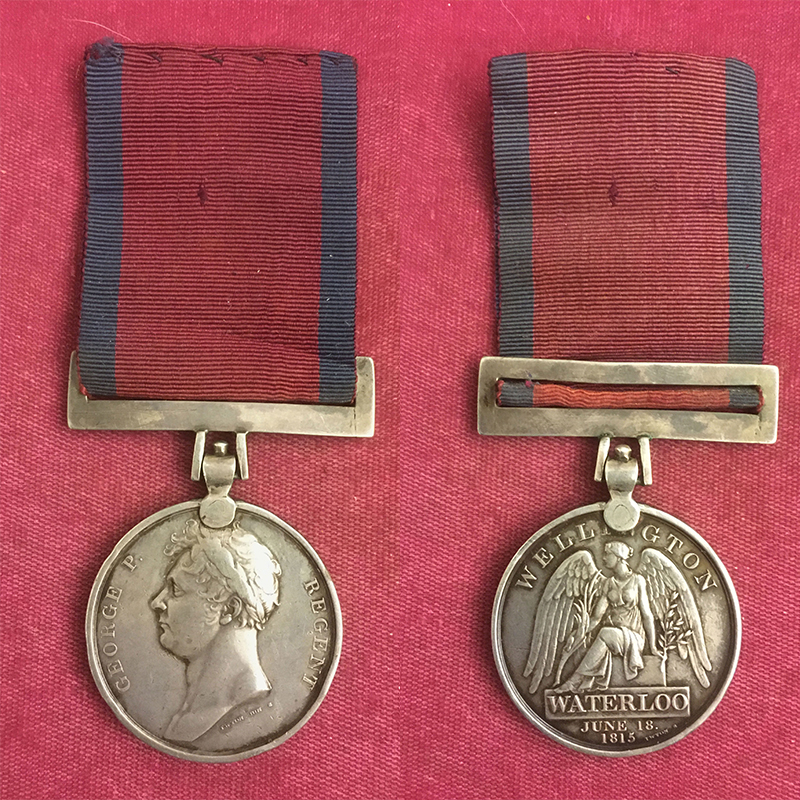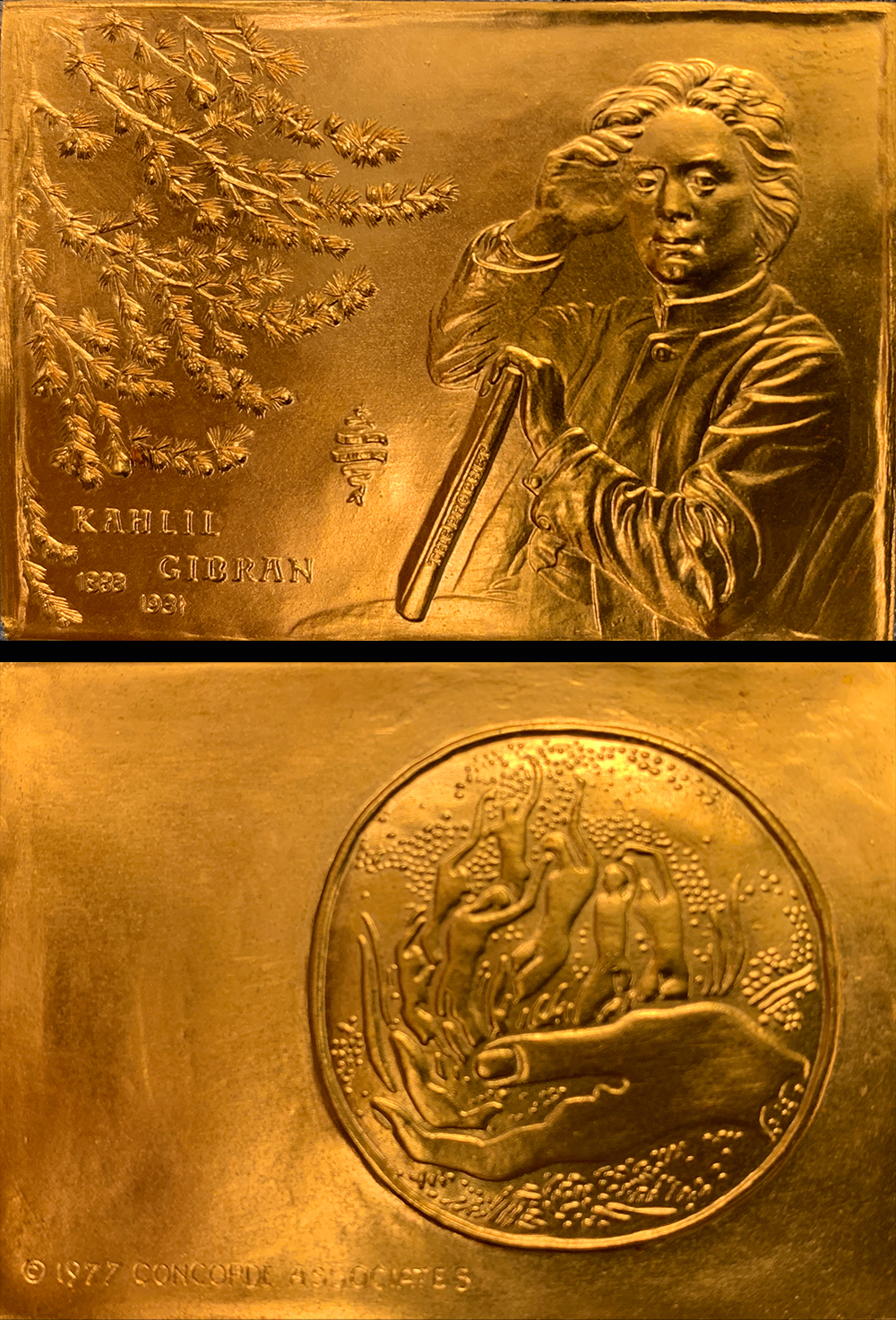The Kahlil G. Gibran Medals Collection
By Bowdoin College Museum of Art
Battle of Waterloo military medal issued to Duke Wellington and the veterans of the Battle of Waterloo, silver, by Thomas Wyon Jr., British, 1792–1817. Gift from the Collection of Kahlil G. Gibran (1922–2008), Bowdoin College Museum of Art.
In December 2019, Jean Gibran generously donated close to 80 medals in memory of her husband, Kahlil George Gibran (1922–2008), a noted sculptor, based in Boston, Massachusetts. Born to parents who had immigrated from Lebanon, Gibran was named after his godfather and cousin, the celebrated writer and artist Gibran Kahlil Gibran. After high school, Kahlil enrolled in the School of the Museum of Fine Arts, Boston where he studied with the painter Karl Zerbe. Kahlil and the generation of Boston artists of which he was a part, many of whom also trained under Zerbe, eventually became known as the Boston Expressionists. To supplement his income as a young artist, Kahlil worked as an instrument maker and conservator of antiquities and instruments for the Museum of Fine Arts, Boston. His reputation as a skilled conservator earned him the nickname “Golden Hands” among his contemporaries.
In the 1950s, Kahlil turned to sculpting. His skill and creativity as a sculptor catapulted Kahlil to international renown. Among the highlights of his many accolades are two Guggenheim Fellowships in 1959 and 1960 respectively, a National Institute of Arts and Letters Award in 1961, and the Gold Medal prize from the International Exhibit of 1966 in Trieste, Italy. While Kahlil’s sculpture can now be found in many prestigious public institutions—such as the Art Institute of Chicago; the Boston Museum of Fine Arts; the Cheekwood Art Center; and the Whitney Museum of American Art—he also created several works of public art for the city of Boston. Kahlil’s many Boston commissions include a bronze relief in Copley Square of Gibran Kahlil Gibran, about whom Kahlil together with his wife Jean co-authored a biography in 1974. In 1981, the city of Boston declared September 26th Kahlil Gibran Day in recognition of his contribution to the arts and beautification of the city.
In addition to his prolific artistic career, Kahlil also worked for several years as an art dealer. As a result of his exposure to a broad range of historical and contemporary art traditions and mediums, Kahlil began collecting portrait medals in the 1970s. Kahlil’s passionate interest in and knowledge about medals ranging from the Renaissance to the twentieth century made him a well-respected presence in the American medal collecting community until his passing in 2008. During his career, Kahlil built three medal collections of note, the first two of which went to the Los Angeles County Museum of Art and the Metropolitan Museum of Art. His final collection has now been donated to the Bowdoin College Museum of Art.
The medals assembled by Kahlil and donated by Jean Gibran are a welcome addition to the BCMA’s collection, and the Museum is grateful to Bowdoin alumnus Stuart Denenberg for helping to make the connection that led to this donation. During the course of my final year of internship at the BCMA, I was able catalogue and study these medals, an exciting opportunity following on the heels of the research for the 2018 exhibition, A Handheld History: Five Centuries of Medals from the Molinari Collection at Bowdoin College.
The Gibran collection represents a strong complement to the BCMA’s already impressive medals collection, filling gaps in the existing BCMA collection, particularly in the areas of British and American medals. One highlight is an important and original Battle of Waterloo military medal issued by the British Crown to the Duke of Wellington. Created by Thomas Wyon Jr., the medal still bears the original silk ribbon and a contemporary nineteenth century suspender. It has special significance as the first ever British military campaign medal issued to all British veterans, including non-officers. Other particularly noteworthy European works include a scarce bronze medal of Louis XIV by Anton Meybusch, a struck original silver 1630 birth medal of Charles II, and two struck original 1661 coronation silver medals of Charles II.
The Gibran collection also includes several important American medals: most notably Augustus Saint-Gauden’s popular medal of George Washington’s Inaugural Centennial from 1889 and John Flanagan’s well-known 1934 medal of Augustus Saint-Gaudens. An Argentinian plaquette by Juan Gottuzzo adds an important example of medallic art created outside of Europe and the United States.
Gibran’s sensitive collecting clearly reflected not only his deep knowledge of the field but also the insight of a sculptor’s study collection for his own interests as a medalist. The Museum is thus particularly happy to add to its collection, through the generosity of Jean Gibran, a fitting example of Gibran’s work: a medallic version of Kahlil’s Copley Square relief honoring his godfather Gibran Kahlil Gibran. Intended to recognize recipients of grants from the original Gibran Kahlil Gibran Educational Scholarship Fund (which now resides with Tufts University), the medal, created in 1977, is a fitting tribute both to Gibran’s career and to the deep-seeded commitment to arts and letters that characterizes his work and his family’s important legacy.
Ben Wu ’18 with Anne Collins Goodyear, Co-Director, Bowdoin College Museum of Art

The Prophet, 1970s, bronze, by Kahlil G. Gibran, American, 1922–2008. Bowdoin College Museum of Art.